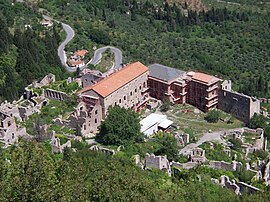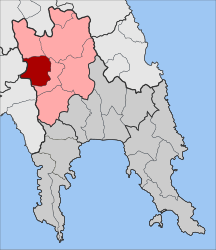Mystras
Mystras
Μυστράς | |
|---|---|
 Mystras' Palace | |
 Mystras show Location within the regional unit | |
| Coordinates: 37°4′N 22°23′E / 37.067°N 22.383°ECoordinates: 37°4′N 22°23′E / 37.067°N 22.383°E | |
| Country | Greece |
| Administrative region | Peloponnese |
| Regional unit | Laconia |
| Municipality | Sparti |
| • Municipal unit | 131.9 km2 (50.9 sq mi) |
| Elevation | 310 m (1,020 ft) |
| Population (2011)[1] | |
| • Municipal unit | 4,265 |
| • Municipal unit density | 32/km2 (84/sq mi) |
| Community | |
| • Population | 832 (2011) |
| Time zone | UTC+2 (EET) |
| • Summer (DST) | UTC+3 (EEST) |
| Postal code | 231 00 |
| Area code(s) | 27310 |
| Vehicle registration | ΑΚ |
UNESCO World Heritage Site | |
| Official name | Archaeological Site of Mystras |
| Criteria | Cultural: ii, iii, iv |
| Reference | 511 |
| Inscription | 1989 (13th Session) |
| Area | 54.43 ha |
| Buffer zone | 1,202.52 ha |
Mystras or Mistras (Greek: Μυστρᾶς/Μιστρᾶς),[2] also known as Myzithras (Μυζηθρᾶς) in the Chronicle of the Morea, is a fortified town and a former municipality in Laconia, Peloponnese, Greece. Situated on Mt. Taygetos, near ancient Sparta, it served as the capital of the Byzantine Despotate of the Morea in the 14th and 15th centuries, experiencing a period of prosperity and cultural flowering during the Palaeologan Renaissance, including the teachings of Gemistus Pletho.[2] The city also attracted artists and architects of the highest quality.[2] The site remained inhabited throughout the Ottoman period, when it was mistaken by Western travellers for ancient Sparta. In the 1830s, it was abandoned and the new town of Sparti was built, approximately eight kilometres to the east. Since the 2011 local government reform it is part of the municipality Sparti, of which it is a municipal unit.[3]
History[]
Foundation and Frankish rule[]


In late 1248, William II of Villehardouin, ruler of the Frankish Principality of Achaea, captured Monemvasia, the last remaining Byzantine outpost on the Morea. This success was soon followed by the submission of the restive Tsakones on Mount Parnon, the Slavic Melingoi tribe of Mount Taygetos, and the inhabitants of the Mani peninsula, thereby extending his sway over all of Laconia and completing the conquest of the peninsula, which had begun in 1205, in the aftermath of the Fourth Crusade.[4] Laconia was incorporated into the princely domain, and the young prince passed the winter of 1248–49 there, touring the country and selecting sites for new fortifications such as Grand Magne and Leuktron; finally, near his residence of Lacedaemon (ancient Sparta), on a spur of Mount Taygetos, he built the fortress that came to be known as Mystras.[2][5]
Byzantine restoration[]
In September 1259, William of Villehardouin was defeated and captured, along with many of his nobles, at the Battle of Pelagonia, by the forces of the Nicaean emperor Michael VIII Palaiologos. Two years later, the Nicaeans recaptured Constantinople, putting an end to the Latin Empire and restoring the Byzantine Empire. At this point, the emperor concluded an agreement with the captive prince: William and his men would be set free in exchange for an oath of fealty, and for the cession of Monemvasia, Grand Magne, and Mystras.[6] The handover was effected in 1262, and henceforth Mystras was the seat of the governor of the Byzantine territories in the Morea. Initially this governor (kephale) was changed every year, but after 1308 they started being appointed for longer terms.[2] Almost immediately on his return to the Morea, William of Villehardouin renounced his oath to the emperor, and warfare broke out between Byzantines and Franks. The first Byzantine attempts to subdue the Principality of Achaea were beaten back in the battles of Prinitsa and Makryplagi, but the Byzantines were firmly ensconced in Laconia. Warfare became endemic, and the Byzantines slowly pushed the Franks back.[7] The insecurity engendered by the raids and counter-raids caused the inhabitants of Lacedaemon to abandon their exposed city and settle at Mystras, in a new town built under the shadow of the fortress.
While Mystras served as the provincial capital from this time, it became a royal capital in 1349 CE, when the first despot was appointed to rule over the Morea. The Byzantine Emperor John VI Kantakouzenos, reorganized the territory in 1349 to establish it as an appanage for his son, the Despot Manuel Kantakouzenos. From 1349 until its surrender to the Ottoman Turks on 31 May 1460, Mystras was the residence of a Despot who ruled over the Byzantine Morea, known as the "Despotate of the Morea". For the larger portion of his reign, Manuel maintained peaceful relations with his Latin neighbors and secured a long period of prosperity for the area. Greco-Latin cooperation included an alliance to contain the raids of Murad I into Morea in the 1360s. The rival Palaiologos dynasty seized the Morea after Manuel's death in 1380, with Theodore I Palaiologos becoming despot in 1383. Theodore ruled until 1407, consolidating Byzantine rule and coming to terms with his more powerful neighbours—particularly the expansionist Ottoman Empire, whose suzerainty he recognised.
This was the city's golden age; according to the Oxford Dictionary of Byzantium, Mystras "witnessed a remarkable cultural renaissance, including the teaching of Plethon, and attracted artists and architects of the highest quality"...[2][2]
Centre of learning and culture[]
Mystras was also the last centre of Byzantine learning and culture; the famous Neoplatonist philosopher George Gemistos Plethon lived there until he died in 1452 CE. While there, Plethon served as a tutor and advisor to the young despot Theodore II until his death in 1452. He and other scholars based in Mystras influenced the Italian Renaissance, especially after he accompanied the emperor John VIII Palaiologos to Florence in 1439.
Ottoman and Venetian years[]
The last Byzantine emperor, Constantine XI Palaiologos, was despot at Mystras before he came to the throne. Demetrius Palaeologus the last despot of Morea, surrendered the city to the Ottoman emperor Mehmed II in 30 May 1460.[8] As Mezistre, it was the seat of a Turkish . The Venetians occupied it from 1687 to 1715, but otherwise the Ottomans held it until 1821. The city joined the Orlov revolt in 1770, the city was looted by Albanian Turks. The metropolitan bishop Ananias was executed despite having saved the life of several Turks during the uprising. A great number of local Greeks were also killed by the Albanian groups, while several children were sold to slavery.[9] Mystras was left in ruins and this event was a significant factor leading up to its abandonment.
Modern years[]
The final straw to Mystras came in 1823 during the Greek war of Independence when Egyptians under the rule of Ibrahim massacred the local population and destroyed the local area.[10] The town was rebuilt 9 km away under the name Sparta in 1831. Most families moved to Sparta, but a few decided to move instead to New Mystras, a small village in the countryside. This process of relocation was completed in 1953 when the remaining properties were confiscated by the municipality.[11] In 1989 the ruins, including the fortress, palace, churches, and monasteries, were named a UNESCO World Heritage Site and features a museum and the partially restored ruins of the city. The only inhabitants today are a group of nuns who reside in the Pantanassa Monastery. The majority of the most important churches are still standing, including St. Demetrios, the Hagia Sophia, St. George, and the Monastery of Peribleptos. The Palace of the Despots has undergone substantial restorations in the past decade, making it a significant attraction. Visitors can reach the ruins via the modern city of Sparti, which is only a few miles from Mystras.
Geography[]
Mystras is situated on the slopes of Taygetos Mountain. The archaeological site stands above the modern village of Mystras and the city of Sparta. The greenery surrounding the area is composed mainly by pine trees and cypresses. Some small rivers and lakes are found in the region.[11]
Subdivisions[]
The municipal unit Mystras is subdivided into the following communities:
- Agia Eirini
- Agios Ioannis Lakedaimonas
- Anavryti
- Barsinikos
- Longastra
- Magoula, the municipality seat of Mystras.
- Mystras
- Paroreio
- Soustianoi
- Trypi
Historical population[]
| Year | Municipal district | Municipal unit |
|---|---|---|
| 1981 | 920 | - |
| 1991 | 525 | 4,592 |
| 2001 | 807 | 4,608 |
| 2011 | 832 | 4,265 |
Notable people[]

People from Mystras[]
- Gemistus Pletho (usually called Plethon) (1355–1452), philosopher and scholar
- Manuel Kantakouzenos, first Despot of Morea
People buried in Mystras[]
- John VI Kantakouzenos
- Manuel Kantakouzenos
- Gemistus Pletho
- Theodora Tocco
- Cleofe Malatesta
Plan[]

- 1. Main entrance;
- 2. Metropolis;
- 3. Evangelistria Church;
- 4. Church of Saints Theodores;
- 5. Hodigitria-Afendiko;
- 6. Monemvasia Gate;
- 7. Church of Saint Nicholas;
- 8. Despot's Palace and square;
- 9. Nauplia Gate;
- 10. Upper entrance to the citadel;
- 11. Church of Hagia Sophia;
- 12. Small Palace;
- 13. Citadel;
- 14. Mavroporta;
- 15. Pantanassa;
- 16. Church of the Taxiarchs;
- 17. House of John Phrangopoulos;
- 18. Peribleptos Monastery;
- 19. Church of Saint George;
- 20. Krevatas House;
- 21. Marmara (entrance);
- 22. Aï-Yannakis;
- 23. Laskaris' House;
- 24. Church of Saint Christopher;
- 25. Ruins;
- 26. Church of Saint Kyriaki.
Gallery[]

Hill of Mystras

Metropolis of Mystras (St Demetrius)
The Byzantine eagle, Metropolis

Monastery of Peribleptos
Entrance of the fortress (view from the inside)

Panorama from the top of Villehardouin's Castle
Evangelistria's church
Hodigitria church

Fresco at Hodigitria's church
A street at the town of Mystras

Despot's Palace (2017)

Pantanassa's monastery

View from Villehardouin's Castle

Upper City

Middle City
A Gate

Agioi Theodoroi

St. George

Agia Sofia
See also[]
- List of settlements in Laconia
- Despotate of Mystras
References[]
- ^ Jump up to: a b "Απογραφή Πληθυσμού - Κατοικιών 2011. ΜΟΝΙΜΟΣ Πληθυσμός" (in Greek). Hellenic Statistical Authority.
- ^ Jump up to: a b c d e f g Gregory & Ševčenko 1991, p. 1382.
- ^ "ΦΕΚ B 1292/2010, Kallikratis reform municipalities" (in Greek). Government Gazette.
- ^ Bon 1969, pp. 72–73.
- ^ Bon 1969, pp. 73, 104.
- ^ Bon 1969, pp. 122–125.
- ^ Bon 1969, pp. 129ff..
- ^ "Mezistre". . 24 June 2021.
- ^ Runciman, Steven (2010). Lost Capital of Byzantium : the History of Mistra and the Peloponnese. John Freely. London: I.B. Tauris & Co. ISBN 978-0-85771-810-5. OCLC 710975289.
- ^ "History of Mystras". www.despotato.gr. Retrieved 2021-09-03.
- ^ Jump up to: a b "History of Mystras | Greeka". Greekacom. Retrieved 2021-09-03.
Sources[]
- Bon, Antoine (1969). La Morée franque. Recherches historiques, topographiques et archéologiques sur la principauté d'Achaïe (in French). Paris: De Boccard.
- Gregory, Timothy E.; Ševčenko, Nancy Patterson (1991). "Mistra". In Kazhdan, Alexander (ed.). The Oxford Dictionary of Byzantium. Oxford University Press. pp. 1382–1385. ISBN 978-0-19-504652-6.
- Runciman, Steven (2009) [1980]. Lost Capital of Byzantium: The History of Mistra and the Peloponnese. Tauris Parke Paperbacks. ISBN 978-1-84511-895-2.)
External links[]
| Wikimedia Commons has media related to Mystras. |
- World Heritage Sites in Greece
- Mystras
- Populated places in Laconia
- Populated places of the Byzantine Empire
- Despotate of the Morea
- Burial sites of the Palaiologos dynasty
- Burial sites of the Kantakouzenos dynasty




















